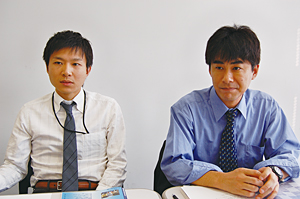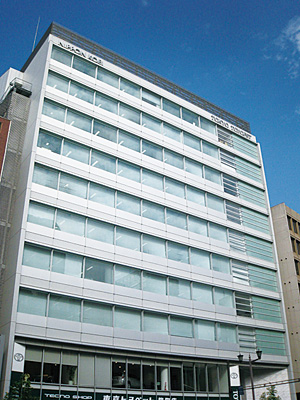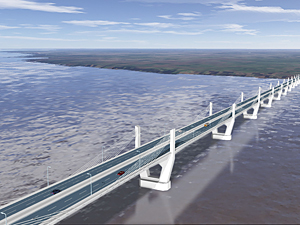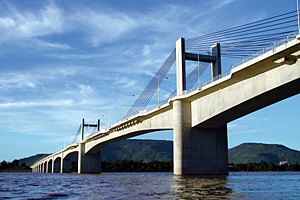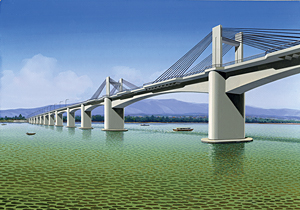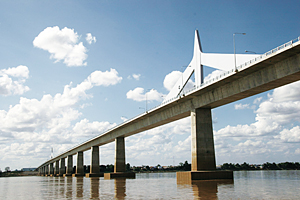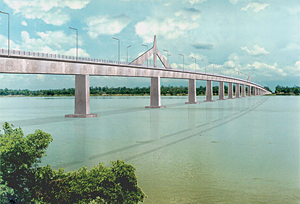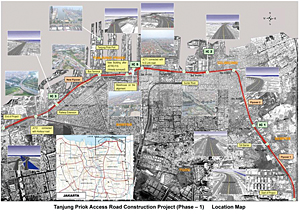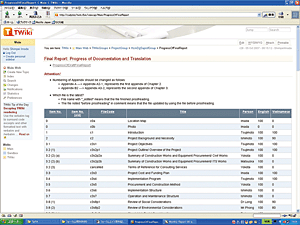Placing More Emphasis on Long Span Bridges and Urban Viaducts that Require Advanced Technology, 3-D Dynamic Nonlinear Analysis Tools are Effectively Used; 3-D VR Attracts Attention for its Potential
This time, let us introduce Nippon Koei Co., LTD., one of the largest construction consultants in Japan. Based on its advanced and broad expertise, Nippon Koei has been trying to solve various technological problems in provision of infrastructure not only in Japan but also in overseas, mainly developing nations. This article focuses on "Highways & Bridge Dept." which belongs to Overseas Consulting Administration of the Company.
In the Company, especially in the Bridge Sector of the said Department, various software programs of the Forum8 supporting design and analyses have been used so far. One of them is "UC-win/FRAME (3D)," upgraded from the former two-dimensional static alignment analyses software "FRAME (2D)." It can also be used for three-dimensional dynamic nonlinear analyses. Another one is "UC-win/Road," recently introduced three-dimensional real-time VR (virtual reality) software. Mr. Takeshi Yoshida, Manager of the Department who are responsible for bridges, and Mr. Shinpei Imada from the same Department talk about them from a view point of actually using them or adopting them after recognizing their effectiveness.
The company is developing its business activities with three administrations as its core: Domestic Consulting Administration, Overseas Consulting Administration, and Power Engineering Administration. Among them, Overseas Consulting Administration consists of three divisions: Urban Social Work Division, Community Division, and Transportation Engineering Division. Transportation Engineering Division is further divided into three departments of Highways & Bridges, Railway Technology, and Ports & Airports.
Highways & Bridges Dept. literally covers services ranging from planning, feasibility study and preliminary examination, planning & research and design to construction supervision of process from start to completion, to maintenance after completion of the projects on highways, bridges, or tunnels. Therefore, it follows that the Bridge Sector of the Department is responsible for different aspects of technology, quality, or safety over the whole lifecycle of a bridge project.
Especially in recent years, as the social and economic environment in developing countries changes, awareness about environment, landscape, or safety has been raised, too. In response to this, Nippon Koei has been promoting bridge projects with environmental emphasis, realization of beautiful bridges by conducting landscaping simulation, participation in disaster prevention and safety inspection projects, nondestructive tests and soundness tests of existing bridges etc. In addition, Nippon Koei is coping with bridge projects that are being complicated and advanced by 1) understanding and operating general design criteria such as AASHTO, BS, or DIN, 2) creating a database to record history of disasters like earthquakes or floods as well as climate and hydrographic conditions all over the world, 3) grasping regional characteristics like design and construction abilities of companies in the local country, and 4) increasing the levels of design technology like capability of 3-D dynamic analysis, as Mr. Takeshi Yoshida explains.
It can be said that these efforts have resulted into the numerous performances in crossings of large rivers with wide areas of basins, accesses to narrows or isolated islands with securing shipping routes, urban viaducts that require dealing with land constraints as well as existing neighboring structures, and bridge construction in a steep mountainous region full of topographic variety. The latest instances are as follows: 1) "Pakxe Bridge Construction Project" (1,380m long, 14-span continuous prestressed concrete (PC) box rigid frame bridge. The three spans in the center form an extradosed bridge with center span length of 143m. It was completed in October, 2000.) The Department took charge of its feasibility study (FS), design, and construction supervision. 2) "Second Mekong International Bridge Construction Project" at the border between Thailand and Laos (2,702m long, 19-span continuous PC box rigid frame bridge. Its navigable waterway part is a box rigid frame bridge with diagonal members. It was completed in December, 2006.) The Department took charge of its detailed design and construction supervision. 3) "Hai Van Tunnel Construction Project" in Vietnam (the longest mountain tunnel in Southeast Asia with the length of 6,274m and two lanes. It was completed in June, 2006.) The Department took charge of its design and construction supervision.
Mr. Takeshi Yoshida pays a special attention to long span bridges and urban viaducts as targets to concentrate their efforts for the future.
"Padma Bridge Construction Plan" is positioned as one of them. This is to construct a multipurpose bridge over the Padma (Ganges) River, one of the major rivers that flow in Bangladesh along with the Jamuna and the Meghna, to provide additional facilities for power transmission, gas supply, and communications. Bangladesh is crisscrossed with lots of rivers, which cause flooding almost every year. Moreover, position of rivers and configuration of the river banks change repeatedly. These not only have an influence on the life of the inhabitants of the river basins, but also form a factor that check the nation's economic development by flooding and damaging trunk roads that support transportation of goods. To solve this problem, a project of connecting the river banks arose by an extremely long span bridge with a length of 5,580m. The project was commissioned b y Japan International Cooperation Agency (JICA) to the Joint Venture of Nippon Koei and Construction Project Consultants Inc. A feasibility study for the project was conducted from March 2003 through March 2005.
"In carrying out a project of this remarkably long bridge among the ones throughout the world, UC-win/FRAME (3D)" was considered to be effective for assuming the structure that would match the requirements of Bangladesh Government and analyzing the scale, structure, or construction costs of the bridge."
Mr. Takeshi Yoshida, who had been utilizing "FRAME (2D)" since some time before, used the study as the occasion to upgrade it to "UC-win/FRAME (3D)" and tried 3-D dynamic nonlinear analysis. The result was summarized in March, 2005 and reported to JICA.
In the meanwhile, Mr. Takeshi Yoshida used "UC-win/FRAME (3D)" for the FS of The Padma Bridge. Then he took notice of its ease of use, since a user could input values while checking the meaning of each numerical value on the screen. He also noticed its feature of detecting problems immediately, as the result of the data could be confirmed visually as soon as they were input. Since then, whenever he makes an official trip to job sites, such as Africa, the Middle and Near East, Southwest Asia, and Southeast Asia, he brought "UC-win/FRAME (3D)" with him and conducted analyses at need. He says that it became possible to detect causes of various troubles that would not have been found with other conventional tools.
"Moreover, since a three-dimensional model created there can be exported to 3DS file, it also has the advantage of reflecting the structure-analyses model into a rendering as it is."
However, there was also a constraint caused by the protective nature of the system. A problem would occur when one had brought the USB key with him or her for a business trip, leaving the other members at the office unable to use it. For this problem, the Forum8 is going to start a new license service that one can access the Forum8's server through the Internet to share "UC-win/FRAME (3D)" by using a password. He shows a strong interest in it and would like to examine it for adoption.
Concerning the Padma Bridge project, different companies have submitted their interest in response to the public notice on its detailed design after that. When a consultant is selected through a short list, it will progress to detailed design and construction next year at the earliest.
Another example of urban viaducts is the "Tanjungpriok Port access road construction plan phase 1," of which detailed design is on progress at present.
So it is planned to construct a 8.1km section between the northeast point of Jakarta Outer Ring Road and the Tanjungpriok Port out of the whole access road to the Tanjungpriok Port (between the northeast point of Jakarta Outer Ring Road and Jakarta bayshore road, 12.1km long), which aims at mitigating traffic jam around the Port. Its purpose is to improve access from the suburbs of Jakarta to the Port and to enhance the expressway network along with its bypass function. Nippon Koei is taking charge of the detailed design, bid assistance, and construction supervision of this project.
In response to the request from the site staff that they wonder if there is a tool to serve for explaining things like complicated ramp structures to the nation's government people concerned, Mr. Shinpei Imada proposed to use "UC-win/Road." It was purchased in the last April. As this is a part of service not included in the agreement, however, and since the schedule of the proper task is so tight, it's not been utilized yet as was originally planned. Nevertheless, it is recognized that "UC-win/Road" has such advantages that it is easy to explain visually unlike other conventional 2-D drawings, that it is possible to create 3-D VR data efficiently by effectively using three dimensional analysis data or other CAD data, and that a designer can check the work on a 3-D form. Therefore, it is expected to be utilized in the later process.
"Various usages can be worked out in future proposals, along with a use to help explaining design to the client like this time."
Developing business activities in all over the world, staff in Highways & Bridges Dept. manages projects by using "Wiki" to share information efficiently within the Department.
This uses a mechanism in which all the members connected on the Web can access and edit. Moreover, as the records can be saved, it is used to create a project implementation support site or a virtual library, or to administer the software programs held in the Department. At the web sites created on project-by-project basis, information like project-related news, a member list, available data etc. is efficiently shared. In addition, it has become easier to find the latest file for a report in progress. He says that while the work procedure of a project is visualized, their task of transmitting heavy files from overseas has been mitigated. This system was installed in 2006, and it is considered to be used for succession of design technique or template disclosure of various documents for the future.
"IT (Information Technology) cannot be put to practical use unless it is convenient or easy to use, including this kind of system or individual tools." Both agree in their opinion that it is important to always inquire from a standpoint of how it is going to be used and what kind of contents are required for that purpose.
We are most grateful to everyone involved for spending time with us for the interview.
